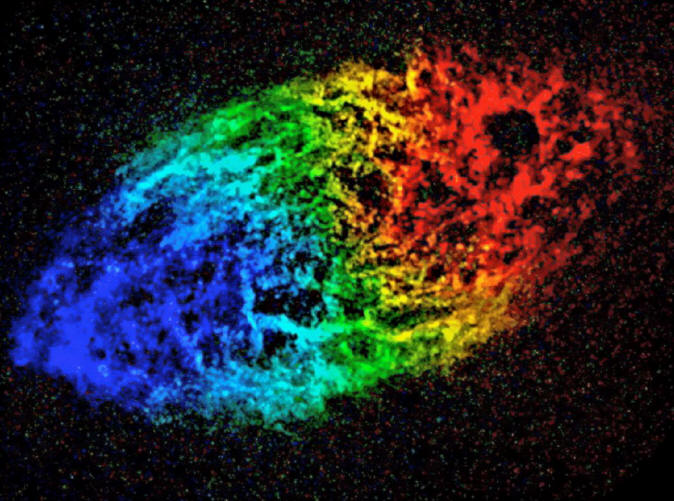|
|
All in the MOND
Feb 18, 2010
Astronomers continue to search
for reasons why galaxies do not
conform to gravitational theories.
In a
previous Picture of the Day
article we noted that NASA
scientists have determined that both
of the Pioneer spacecraft are off
course by more than a hundred
thousand kilometers. At the time,
investigative team members remarked
that they had no explanation for the
navigational deviation, so many
speculations were offered about what
“mysterious” forces could be acting
on the most distant of artificial
objects. Multidimensional space,
dark energy, dark matter "friction,"
and other ironic theories such as
“gravity affecting antimatter
differently” were offered to the
scientific press as "explanations"
for the deceleration.
In
September 1998 the same
inexplicable "tug" seemed be acting
on the now defunct Ulysses
spacecraft as it swung through the
Solar System in a high orbit over
the Sun's poles. Ulysses exhibited
an anomalous acceleration toward the
Sun when radio signals from Earth
were returned from an onboard
transponder. A Doppler shift in the
frequency of the return transmission
indicated a variance greater than
could be accounted for by known
mechanisms—as of today, no one in
the conventional science community
can provide a solid explanation for
it.
Telemetry from NEAR-Shoemaker, the
Galileo mission to Jupiter, Cassini-Equinox,
the
Rosetta cometary probe, and the
MESSENGER mission to Mercury reveal
similar discrepancies. Astronomers
are baffled by this information
because standard theories of motion
in the cosmos rest within a
gravitational model.
Modified Newtonian Dynamics (MOND),
a theory developed in the early
1980s by Mordehai Milgrom, was also
suggested as a possible reason for
the effects on the various space
probes, although Milgrom himself
feels that MOND is far too diffuse a
force to affect such small objects.
Perhaps the suggestion is no more
inexact than those previously
mentioned.
However, on the large scale,
according to MOND theory, gravity
can vary depending on acceleration.
Since the velocity measurements of
some stars at the edges of various
galaxies seem to demonstrate greater
speeds than they should, Milgrom
proposed that gravity can alternate
between two states: one where its
influence falls off with the square
of the distance—Newtonian gravity,
and one where its force is linear,
declining with the distance—MOND.
According to a recent
press release, anomalies in the
rotational velocity versus the
gravitational binding of stars
within galactic orbits may not
require the existence of dark matter
to provide additional attractive
force.
MOND was offered as an alternative
to cold, dark matter's inferred
gravity field. Since stars on the
outskirts of galactic disks revolve
at greater-than-apparently-possible
velocities, they "must be"
experiencing the effects of an
unseen and undetectable mass. In
short, a volume of dark matter
exists in and around many galaxies
that is five times the volume of
normal matter. It is the invisible
matter that is exerting itself so
strongly. See the Picture of the Day
"Detecting
the Undetectable" for more
information.
Both of these phenomena, the
deceleration of space probes in the
Solar System, as well as the
unexpected stellar velocities in
galaxies, can be explained by one
thing: electricity flowing through
dusty plasma.
As a spacecraft travels through the
interplanetary medium it builds up a
negative charge differential with
respect to the positive charge of
the Sun. The Sun's weak, radial
electric field, extending outward
for almost a light-day without
diminishing, and generated by the
movement of charged particles known
as the "solar wind," draws the
negatively charged object back
toward itself.
The linear attributes of MOND
gravity theory are a powerful hint
at what might actually be taking
place in galaxies as well as star
systems. Since electric forces can
scale by many orders of magnitude,
the weak, radial electric field of
the Milky Way galaxy, for example,
is most likely doing the same thing
to the stars at its outer boundary
as the Sun is doing to the charged
objects within its sphere of
influence.
The Sun is not keeping its family of
planets in lockstep by gravity
alone, its electric field is also
acting in an additional, if not
principle manner. It is the e-field
of the galaxy that is keeping the
stars in orbit around the nucleus
with the addition of the far less
powerful gravitational field. If
e-fields and electrical transmission
over star-spanning distances would
be given their due, MOND, dark
matter and all the other ad hoc Big
Bang theories would vanish.
Stephen Smith
|
|
|
|
|
|
|
|
|
YouTube video, first glimpses of Episode Two in the "Symbols of an Alien Sky"
series.
|
|
|
|
|
|
|
Three ebooks in the Universe Electric series are
now available. Consistently
praised for easily understandable text and exquisite graphics.
|
|
|
|
|
|
|
|
|
|







